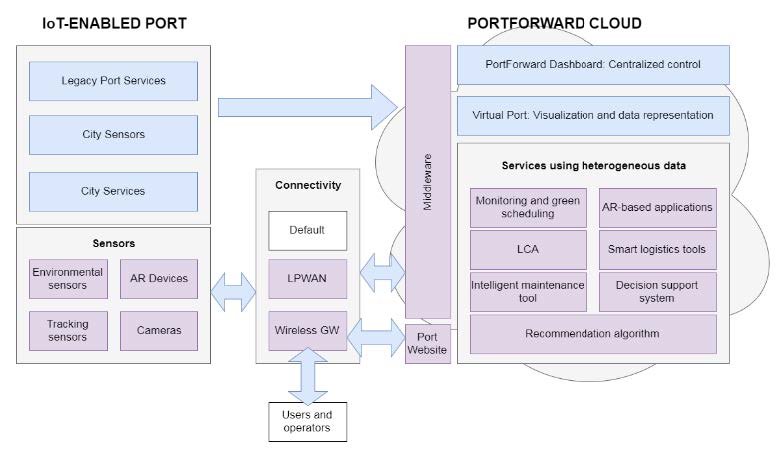The holistic approach to a smarter, greener and more sustainable port ecosystem
Challenges
PortForward will attempt to address important challenges that today’s ports are facing in order to take a substantial step towards the Port of the Future. More specifically the following needs are addressed:
- Lack of efficiency in operations with heterogeneous freights (roll-on/roll-off cargo, containers), such as inefficient land use, berth scheduling & quay crane allocation, quay crane scheduling & bay sequencing, yard configuration & stacking policies, and lack of monitoring of the depth of access channels and quays, which varies due to silting
- Need for real time monitoring of freight flows through the use of end-to-end track-and-trace solutions in order to optimize port activities
- Need for remote monitoring and management of important port operations, such as maintenance scheduling, cargo and passenger traffic, especially for short sea shipping cases
- Interconnection with hinterland transportation with special focus on inland waterways
Interface with the surrounding urban environment - Experience sharing and transferability to other intermodal transport hubs (ports, airports, etc.)
- Environmental impact reduction through the use of green technologies and energy solutions saving
Objectives
O1: To develop a novel smart logistics platform for ports that will improve cargo real time traceability (5 sec latency), positioning precision (5m accuracy), and stowage plan optimization for both Ro-Ro and container traffic, in order to increase revenues from cargo handling through the improvement of related operational indicators such as waiting and service times (reduction by 15%), and tons of cargo handled per ship-hours in port (increase by 20%)
O2: To develop a remote management and maintenance platform for ports that provides seamless access and insight into port Key Performance Indicators (KPIs) and alerts, by integrating novel monitoring and communication technologies with already existing port management subsystems, using innovative Virtual Reality (VR) visualization of processes, objects and parameters
O3: Internet of Things (IoT) middleware that facilitates the deployment, discovery and management and unifies the interaction with 1) heterogeneous connected sensors/actuators, 2) tracking devices and 3) connected workers, thereby making use of both short, medium and long range wireless connectivity and leveraging on open IoT standards such as LWM2M/IPSO
O4: To develop a novel green scheduler (GS) for yard operations as a core component of the DSS by considering energy consumption and fuel emissions by trucks, ships, cranes, etc.(target reduction of 10% for both), as explicit objectives besides service- and cost- oriented KPIs
O5: Augmented Reality solutions will support in fast maintenance and remote decision making and safe navigation of vessels within the port. This requires O5.1 the development of a Remote-Assistance Tool for on-site maintenance of critical infrastructure and fast problem solving
O6: To develop and to demonstrate a Virtual Port Tool for VR- and AR-based visualisation of port operations and process statuses
O7: To trigger stakeholder engagement for the whole port-related supply chain including actors like Port Authorities, terminal operators, shipping companies, customs, security forces, city authorities, etc. for issues regarding the environmental footprint of the port to the port city, the interoperability of the PortForward solutions, the intermodality with the rest of the logistics value chain and transferability to other types of terminals (rail, freight, air, etc.)
O8: To study the socioeconomic effect of the port emissions to the surrounding area and the impact to the port city logistics and transport operations, including the hinterland transport network (Vigo, Livorno, MARTE, Magdeburg), short sea shipping (Baleares, MARTE) and inland waterways, in the inland port of Magdeburg
O9: To develop the PortForward Dashboard to integrate all separate PortForward tools and provide real time monitoring to the port operators. The Dashboard will be complementary as a visualisation option with the Virtual Port module
O10: To validate the PortForward solution in 5 relevant use cases focusing on implementing the technologies in port environments, with a focus on short sea, intermodal transportation (especially rail) and inland waterways
Approach
To address the aforementioned problems PortForward proposes a holistic approach that will lead to a smarter, greener and more sustainable port ecosystem and which will include the following features:
- The introduction of an Internet of Things (IoT) concept for port assets (infrastructure, vehicles, cargo, people and processes)
- Sensor deployment, including cameras, multi-modal tracking devices, etc.
- Interconnection into one seamless, versatile and secure IoT network
- Remote management and intelligent maintenance tool
- Virtual Port tool embedded in the PortForward Dashboard providing centralized control and alternative visualisations
- Novel smart logistics platform with Decision Support System (DSS)
- Environmental and energy monitoring /optimisation system using the novel concept of Green Yard Scheduling
- Augmented Reality (AR) for pilot assistance and remote assistance to workers/operators
- Information exchange layer with other stakeholders, e.g. city services
- The socio-economic analysis of the port interface with its surrounding area and the port-city, as well as the rest of the logistics value chain. An Advisory Board (AB) will be formed in the first months of the project, comprising all actors of the value chain, as well as city authorities, shipping companies, logistics companies, etc.
PortForward Concept Diagram

